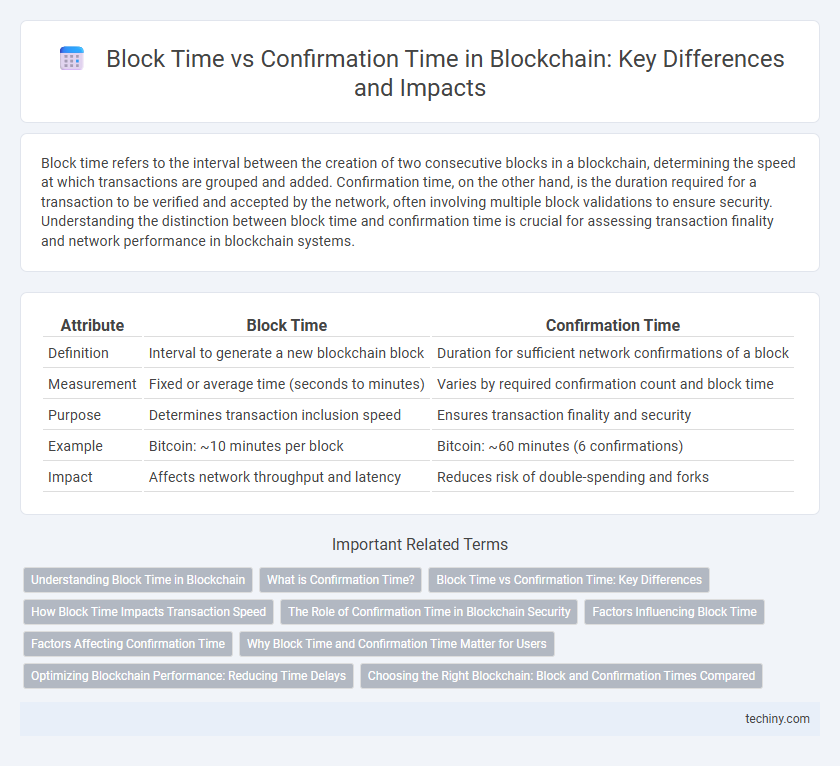Block time refers to the interval between the creation of two consecutive blocks in a blockchain, determining the speed at which transactions are grouped and added. Confirmation time, on the other hand, is the duration required for a transaction to be verified and accepted by the network, often involving multiple block validations to ensure security. Understanding the distinction between block time and confirmation time is crucial for assessing transaction finality and network performance in blockchain systems.
Table of Comparison
| Attribute | Block Time | Confirmation Time |
|---|---|---|
| Definition | Interval to generate a new blockchain block | Duration for sufficient network confirmations of a block |
| Measurement | Fixed or average time (seconds to minutes) | Varies by required confirmation count and block time |
| Purpose | Determines transaction inclusion speed | Ensures transaction finality and security |
| Example | Bitcoin: ~10 minutes per block | Bitcoin: ~60 minutes (6 confirmations) |
| Impact | Affects network throughput and latency | Reduces risk of double-spending and forks |
Understanding Block Time in Blockchain
Block time in blockchain refers to the average duration required to generate a new block and add it to the blockchain, typically ranging from seconds to minutes depending on the protocol. It significantly impacts network throughput and transaction processing speed, influencing how quickly transactions are confirmed and considered secure. Understanding block time helps in evaluating transaction latency, network security, and the trade-offs between speed and decentralization in blockchain systems.
What is Confirmation Time?
Confirmation time in blockchain refers to the duration it takes for a transaction to be verified and added to a block that is permanently recorded on the distributed ledger. It reflects the number of blocks added after the block containing the transaction, ensuring the immutability and security of the transaction against reversals or double-spending. This metric is crucial for users assessing the reliability and finality of transactions within networks like Bitcoin and Ethereum.
Block Time vs Confirmation Time: Key Differences
Block time refers to the average duration required to generate a new block on a blockchain, typically measured in seconds or minutes, such as Bitcoin's 10-minute block time or Ethereum's 13-second block time. Confirmation time is the period taken for a transaction to be included in a block and deemed secure after multiple subsequent blocks are added, often expressed in the number of confirmations, with Bitcoin commonly requiring six confirmations for finality. Understanding the key differences between block time and confirmation time is essential for assessing transaction speed and network security in blockchain environments.
How Block Time Impacts Transaction Speed
Block time directly affects transaction speed by determining how quickly new blocks are added to the blockchain, with shorter block times enabling faster transaction confirmation. Confirmation time depends on the number of required block confirmations for security, meaning a faster block time reduces overall waiting periods for transaction finality. Networks like Bitcoin with a 10-minute block time experience slower transaction speeds compared to Ethereum, which averages around 13 seconds per block, resulting in quicker confirmations.
The Role of Confirmation Time in Blockchain Security
Confirmation time is a critical metric in blockchain security, representing the period required for a transaction to be irreversibly added to the blockchain after initial block validation. While block time measures the interval between the creation of consecutive blocks, confirmation time extends this by including additional blocks appended to secure transactional finality and prevent double-spending. Increased confirmation time enhances protection against blockchain reorganizations and 51% attacks, ensuring greater trustworthiness and immutability of recorded data.
Factors Influencing Block Time
Block time, the interval between the creation of successive blocks on a blockchain, is primarily influenced by factors such as network hash rate, mining difficulty, and consensus algorithm. Higher network hash rate typically reduces block time as miners solve blocks faster, while increased mining difficulty adjusts to maintain consistent timing despite rising computational power. Consensus mechanisms like Proof of Work or Proof of Stake also significantly impact block time by determining how quickly blocks are validated and added to the chain.
Factors Affecting Confirmation Time
Confirmation time on a blockchain is influenced by factors such as block time, network congestion, and transaction fee prioritization. Block time, the average interval between blocks, sets the baseline for how quickly transactions can be added to the ledger, while higher transaction fees generally lead to faster inclusion due to miner incentives. Network congestion and the mempool size directly impact confirmation delays, as transactions compete for limited block space.
Why Block Time and Confirmation Time Matter for Users
Block time determines how frequently new blocks are added to the blockchain, directly affecting transaction throughput and system responsiveness. Confirmation time reflects the delay users experience before a transaction is considered secure, influencing trust and usability in applications like payments or smart contracts. Optimizing both block time and confirmation time enhances user experience by balancing speed, security, and network stability on platforms such as Bitcoin, Ethereum, and other major blockchains.
Optimizing Blockchain Performance: Reducing Time Delays
Block time refers to the interval required to generate a new block, while confirmation time includes the additional period for subsequent blocks to ensure transaction security. Reducing block time accelerates transaction throughput but may increase the risk of orphaned blocks, impacting network stability. Optimizing consensus algorithms and enhancing network propagation protocols effectively minimize confirmation delays, balancing speed with security to improve overall blockchain performance.
Choosing the Right Blockchain: Block and Confirmation Times Compared
Block time refers to the average interval between the creation of consecutive blocks in a blockchain, directly impacting transaction speed. Confirmation time measures how long it takes for a transaction to be considered secure after several blocks have been added on top, ensuring network consensus and reducing the risk of double-spending. Selecting the right blockchain involves balancing faster block times for quicker transactions against longer confirmation times for higher security and finality.
block time vs confirmation time Infographic

 techiny.com
techiny.com